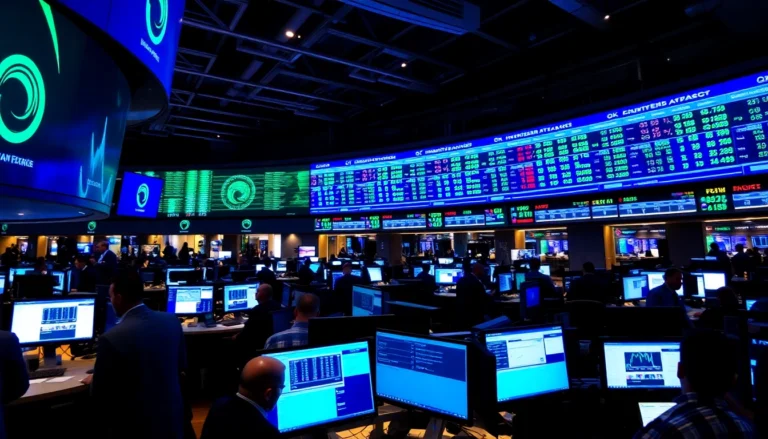Introduction to Trading View and Its Core Features
In today’s fast-paced financial markets, traders and investors require robust tools to analyze, interpret, and act on market data efficiently. trading view has established itself as a premier platform that consolidates charting, analytics, and social interaction into a comprehensive environment. Its widespread popularity among retail traders, professional investors, and institutions alike underscores its effectiveness in facilitating market insights. This article explores the extensive capabilities of Trading View, providing actionable guidance on leveraging its features for optimal trading performance.
Overview of Trading View as a Market Analysis Tool
Trading View is more than just a charting software; it is an integrated ecosystem that combines technical analysis, real-time data, community-driven ideas, and automated alerts. Its cloud-based architecture ensures accessibility across devices, enabling users to stay connected to markets anytime, anywhere. Its comprehensive data feeds include global indices, cryptocurrencies, forex pairs, commodities, and individual stocks, offering a panoramic view of financial markets. Additionally, its social features foster a collaborative environment where traders can share insights, strategies, and forecasts, enriching the analytical process.
Key Features: Charts, Indicators, and Social Insights
At the core of Trading View are its advanced charts, which currently support multiple types such as candlestick, bar, and line charts, alongside customizable timeframes ranging from seconds to monthly views. Coupled with an extensive library of over 100 technical indicators—like Moving Averages, RSI, MACD, Ichimoku Cloud—users can craft tailored analysis setups. Unique social features, including ideas, comments, and live chat, enable traders to exchange real-time insights, validate strategies, and gather diverse perspectives. The ability to embed charts into websites or share them directly empowers a collaborative analysis environment.
Benefits of Using Trading View for Traders and Investors
Utilizing Trading View offers numerous advantages, such as enhanced decision-making through precise visualizations, access to community-generated insights, and seamless integration with brokerage accounts for trading execution. Its user-friendly interface reduces the learning curve, making sophisticated tools accessible even for beginners. Moreover, the platform’s real-time alerts and notifications enable timely responses to market movements, increasing trading flexibility. These combined features streamline the entire trading workflow from analysis to execution, which is vital in volatile markets.
How to Set Up and Customize Trading View for Optimal Performance
Creating an Account and Navigating the Interface
Getting started with Trading View involves creating a free account, which grants access to essential features with options for premium plans that unlock advanced functionalities. Upon signing up, users land on a clean interface divided into several sections: the main chart window, watchlists, indicators panel, and a social chat stream. Navigating this environment is intuitive—menu options allow quick access to chart settings, layout customization, and data feeds. Familiarizing oneself with the layout helps in efficient workspace management, crucial for quick trading decisions.
Personalizing Watchlists and Chart Layouts
One of the platform’s strengths is its high degree of personalization. Traders can create multiple watchlists for different asset classes, categorizing stocks, cryptocurrencies, or forex pairs based on their strategies. Customizable chart layouts enable users to set up multiple charts with different timeframes or indicators side-by-side, facilitating comparative analysis. Implementing themes—dark or light—further enhances visual comfort, especially during extended trading sessions. Mastering these customization options ensures that your workspace aligns precisely with your trading style, boosting efficiency and accuracy.
Integrating External Data and Tools for Advanced Analysis
For traders seeking granular control, Trading View supports integration with external data sources and tools. Scripts written in Pine Script—a proprietary language—allow customization of indicators and strategies, enabling algorithmic trading. Additionally, integration with brokerage APIs lets traders directly execute trades from within the platform, reducing latency and manual intervention. Using external news feeds or economic calendars within Trading View enhances fundamental analysis, providing a holistic market view essential for informed decision-making.
Best Practices for Using Trading View to Detect Market Trends
Applying Technical Indicators Effectively
Technical indicators are vital for identifying trends, potential reversals, and market momentum. Successful traders avoid overloading their charts—selecting a handful of complementary indicators that suit their trading style is more effective. For example, combining Moving Averages with RSI can help confirm trend direction and overbought/oversold conditions. Regularly backtesting these indicators through Trading View’s replay feature assists in understanding their reliability within different market contexts, informing better decision-making.
Using Drawing Tools for Pattern Recognition
Drawing tools like trend lines, Fibonacci retracements, and chart patterns (head and shoulders, double tops/bottoms) are instrumental for visual pattern recognition. Mastery of these tools allows traders to anticipate potential shifts in market direction. For instance, identifying a bullish divergence using RSI and drawing trendlines to confirm breakouts can signal entry points. Practicing pattern recognition on various timeframes improves forecast accuracy, especially during volatile periods.
Combining Social Ideas with Data-Driven Strategies
Community insights within Trading View can provide valuable market sentiment and alternative viewpoints. Incorporate social ideas by analyzing popular trader forecasts and comparing them with your technical analysis. Cross-referencing multiple opinions enhances risk management, helping to avoid herd behavior traps. Additionally, tracking the performance of shared ideas over time allows you to identify consistently successful strategies, refining your overall approach.
Leveraging Trading View for Automated Alerts and Trading
Setting Custom Alerts for Price and Indicator Movements
Timely alerts are crucial in the fast-moving markets, allowing traders to react without constantly monitoring screens. Trading View enables setting custom alerts based on price levels, indicator readings, or drawing tools. For example, a trader can set an alert when Bitcoin exceeds a certain threshold or when RSI indicates oversold conditions. These alerts can be sent via email, SMS, or app notifications, making sure opportunities aren’t missed.
Connecting Trading View to Brokerage Accounts
Many brokers directly integrate with Trading View, enabling seamless order placement. Setting up this connection involves linking your broker account through the platform’s interface, which simplifies the process of executing trades based on technical signals. It reduces latency, especially critical in high-frequency environments, and consolidates analysis and trading into a single environment, improving operational efficiency.
Implementing Automated Trading Strategies Safely
Advanced users can create automated trading strategies using Pine Script, testing and deploying them within Trading View. The proper implementation involves rigorous backtesting, forward testing in demo accounts, and setting protective stop-loss and take-profit levels. Starting with conservative parameters minimizes risk. Regular monitoring of algorithm performance allows adjustments in response to market changes, ensuring that automation enhances rather than hampers your trading results.
Analyzing Performance Metrics and Enhancing Your Trading Results
Tracking Strategy Effectiveness with Trading View Analytics
Performance analysis is essential for continuous improvement. Trading View’s native tools and third-party integrations enable tracking key metrics such as win rate, profit factor, drawdown, and consistency. Visual dashboards provide quick insights into strategy performance over time and across different assets. This analytical feedback loop allows traders to identify strengths and weaknesses, refining their approach accordingly.
Adjusting Techniques Based on Data Insights
Data-driven adjustments are fundamental. By reviewing historical analysis and trade logs, traders can fine-tune indicator parameters, optimize entry/exit points, and adjust risk management strategies. Emphasizing adaptability ensures that techniques remain effective despite changing market conditions, improving overall profitability.
Case Studies: Successful Traders Using Trading View
Numerous traders have documented their success stories utilizing Trading View’s robust features. For example, a day trader might optimize their scalp trades using real-time alerts and pattern recognition, while a swing trader relies on multi-timeframe analysis and community ideas. These case studies underscore the platform’s versatility and effectiveness in supporting diverse trading styles, serving as a valuable resource for aspiring and experienced traders alike.







